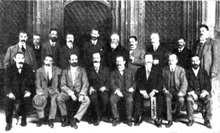Commonwealth of Catalonia

The Commonwealth of Catalonia (Catalan: Mancomunitat de Catalunya, IPA: [məŋkumuniˈtad də kətəˈɫuɲə]) was an institution which grouped the four diputacions (provincial administrations) of Catalonia. It was created on 6 April 1914, although the process of creating the institution had started in 1911, and was disbanded and outlawed in 1925 during Miguel Primo de Rivera's dictatorship.[1]
History
The Lower House of the Spanish Parliament approved the creation of a Commonwealth with limited powers compared to those originally envisioned for it, however the Spanish Senate never approved the creation of the authority. On 18 December 1913 the king signed the law granting provinces the right to group themselves into associations such as the Catalan Commonwealth.
The Commonwealth was formed by the federation of the four Catalan provincial councils, a long-standing demand on the part of the Catalans. Even though it was restricted to purely administrative functions, and its powers did not go beyond those of the provincial administrations, it acquired great political importance: it represented the first recognition by the Spanish state of the existence and of the unity of Catalonia since the year 1714.
Its first President was Enric Prat de la Riba and afterwards the architect Josep Puig i Cadafalch, both of the Lliga Regionalista, who carried out the important task of creating an efficient infrastructure of roads and ports, hydraulic works, railways, telephones, charities and health provision. The Commonwealth also undertook initiatives to increase agricultural and forest yields, introducing technological improvements, the improvement of services and education, and promoting education in technologies necessary for Catalan industry.
It created and consolidated a set of cultural and scientific institutions in order to give greater prestige to Catalan language and culture, such as the Institut d'Estudis Catalans (Institute of Catalan Studies), the Biblioteca de Catalunya (Library of Catalonia), the Escola Industrial (Industrial School), the Escola Superior de Belles Arts (College of Fine Arts), the College of Higher Commercial Studies or the Escola del Treball (College of Industry). Prat de la Riba also created, the Escola de l'Administració Local (School of Local Administration), and required Catalan civil servants to have attended this institution.
Another important milestone of the Commonwealth was the promotion of the work of Pompeu Fabra, who was chiefly responsible for the current Catalan writing system and linguistic standard.
The Commonwealth was dissolved and outlawed under Miguel Primo de Rivera's dictatorship on 20 March 1925.[2]
References
- ↑ "Towards autonomy: the Commonwealth of Catalonia, 1914-1925". Generalitat de Catalunya. Archived from the original on 19 March 2013. Retrieved 11 April 2012.
- ↑ Entry for Mancomunitat de Catalunya on Enciclopedia.cat http://www.enciclopedia.cat/EC-GEC-0039693.xml